Spring Cloud Alibaba:Sentinel实现熔断与限流
Spring Cloud Alibaba 致力于提供微服务开发的一站式解决方案,Sentinel 作为其核心组件之一,具有熔断与限流等一系列服务保护功能,本文将对其用法进行详细介绍。
Sentinel简介
随着微服务的流行,服务和服务之间的稳定性变得越来越重要。 Sentinel 以流量为切入点,从流量控制、熔断降级、系统负载保护等多个维度保护服务的稳定性。
Sentinel具有如下特性:
- 丰富的应用场景:承接了阿里巴巴近 10 年的双十一大促流量的核心场景,例如秒杀,可以实时熔断下游不可用应用;
- 完备的实时监控:同时提供实时的监控功能。可以在控制台中看到接入应用的单台机器秒级数据,甚至 500 台以下规模的集群的汇总运行情况;
- 广泛的开源生态:提供开箱即用的与其它开源框架/库的整合模块,例如与 Spring Cloud、Dubbo、gRPC 的整合;
- 完善的 SPI 扩展点:提供简单易用、完善的 SPI 扩展点。您可以通过实现扩展点,快速的定制逻辑。
安装Sentinel控制台
Sentinel控制台是一个轻量级的控制台应用,它可用于实时查看单机资源监控及集群资源汇总,并提供了一系列的规则管理功能,如流控规则、降级规则、热点规则等。
-
我们先从官网下载Sentinel,这里下载的是
sentinel-dashboard-1.6.3.jar文件,下载地址: github.com/alibaba/Sen… -
下载完成后在命令行输入如下命令运行Sentinel控制台:
java -jar sentinel-dashboard-1.6.3.jar 复制代码
- Sentinel控制台默认运行在8080端口上,登录账号密码均为
sentinel,通过如下地址可以进行访问: http://localhost:8080

- Sentinel控制台可以查看单台机器的实时监控数据。
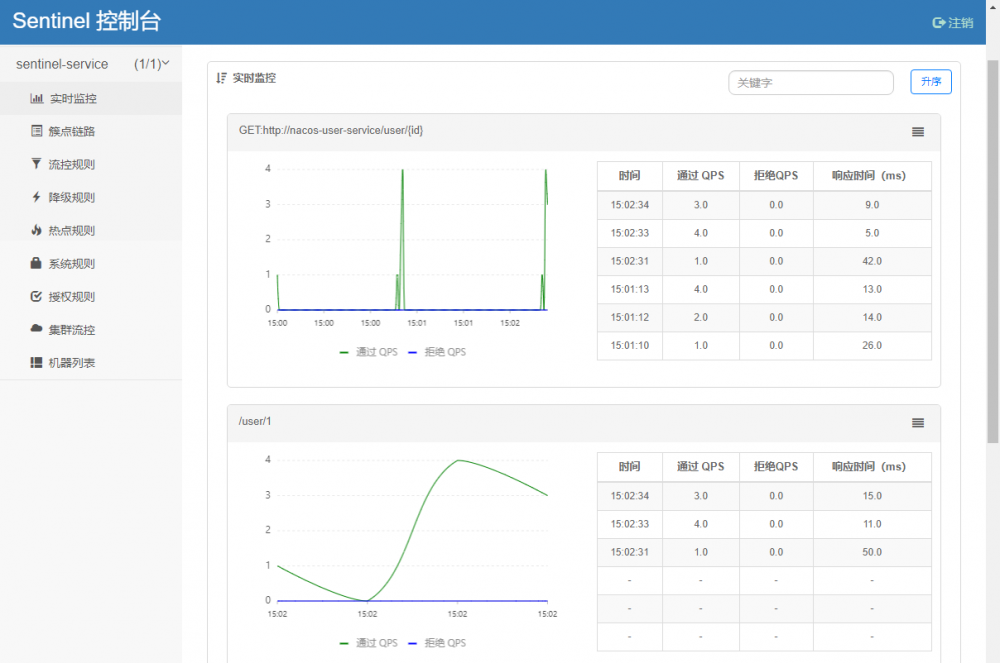
创建sentinel-service模块
这里我们创建一个sentinel-service模块,用于演示Sentinel的熔断与限流功能。
- 在pom.xml中添加相关依赖,这里我们使用Nacos作为注册中心,所以需要同时添加Nacos的依赖:
<dependency>
<groupId>com.alibaba.cloud</groupId>
<artifactId>spring-cloud-starter-alibaba-nacos-discovery</artifactId>
</dependency>
<dependency>
<groupId>com.alibaba.cloud</groupId>
<artifactId>spring-cloud-starter-alibaba-sentinel</artifactId>
</dependency>
复制代码
- 在application.yml中添加相关配置,主要是配置了Nacos和Sentinel控制台的地址:
server:
port: 8401
spring:
application:
name: sentinel-service
cloud:
nacos:
discovery:
server-addr: localhost:8848 #配置Nacos地址
sentinel:
transport:
dashboard: localhost:8080 #配置sentinel dashboard地址
port: 8719
service-url:
user-service: http://nacos-user-service
management:
endpoints:
web:
exposure:
include: '*'
复制代码
限流功能
Sentinel Starter 默认为所有的 HTTP 服务提供了限流埋点,我们也可以通过使用@SentinelResource来自定义一些限流行为。
创建RateLimitController类
用于测试熔断和限流功能。
/**
* 限流功能
* Created by macro on 2019/11/7.
*/
@RestController
@RequestMapping("/rateLimit")
public class RateLimitController {
/**
* 按资源名称限流,需要指定限流处理逻辑
*/
@GetMapping("/byResource")
@SentinelResource(value = "byResource",blockHandler = "handleException")
public CommonResult byResource() {
return new CommonResult("按资源名称限流", 200);
}
/**
* 按URL限流,有默认的限流处理逻辑
*/
@GetMapping("/byUrl")
@SentinelResource(value = "byUrl",blockHandler = "handleException")
public CommonResult byUrl() {
return new CommonResult("按url限流", 200);
}
public CommonResult handleException(BlockException exception){
return new CommonResult(exception.getClass().getCanonicalName(),200);
}
}
复制代码
根据资源名称限流
我们可以根据@SentinelResource注解中定义的value(资源名称)来进行限流操作,但是需要指定限流处理逻辑。
-
流控规则可以在Sentinel控制台进行配置,由于我们使用了Nacos注册中心,我们先启动Nacos和sentinel-service;
-
由于Sentinel采用的懒加载规则,需要我们先访问下接口,Sentinel控制台中才会有对应服务信息,我们先访问下该接口: http://localhost:8401/rateLimit/byResource
-
在Sentinel控制台配置流控规则,根据@SentinelResource注解的value值:
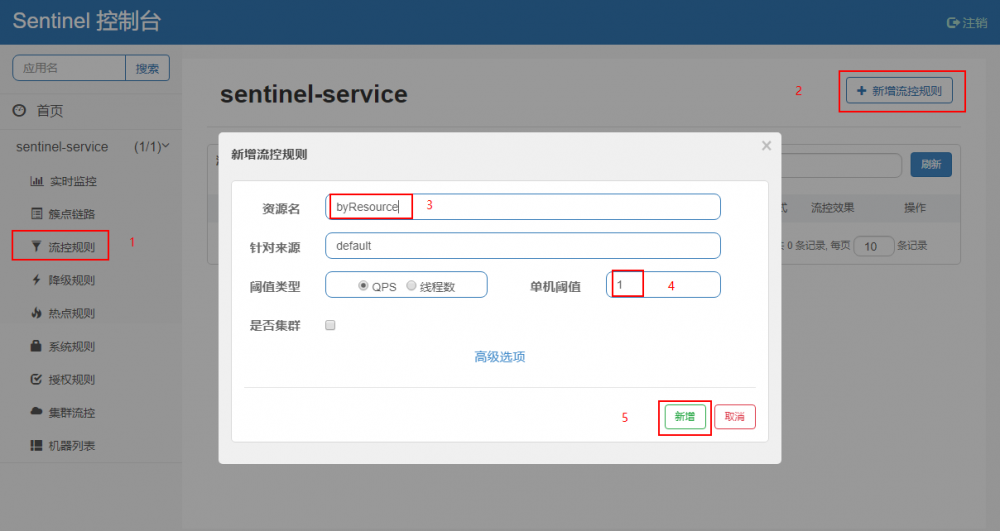
- 快速访问上面的接口,可以发现返回了自己定义的限流处理信息:

根据URL限流
我们还可以通过访问的URL来限流,会返回默认的限流处理信息。
- 在Sentinel控制台配置流控规则,使用访问的URL:
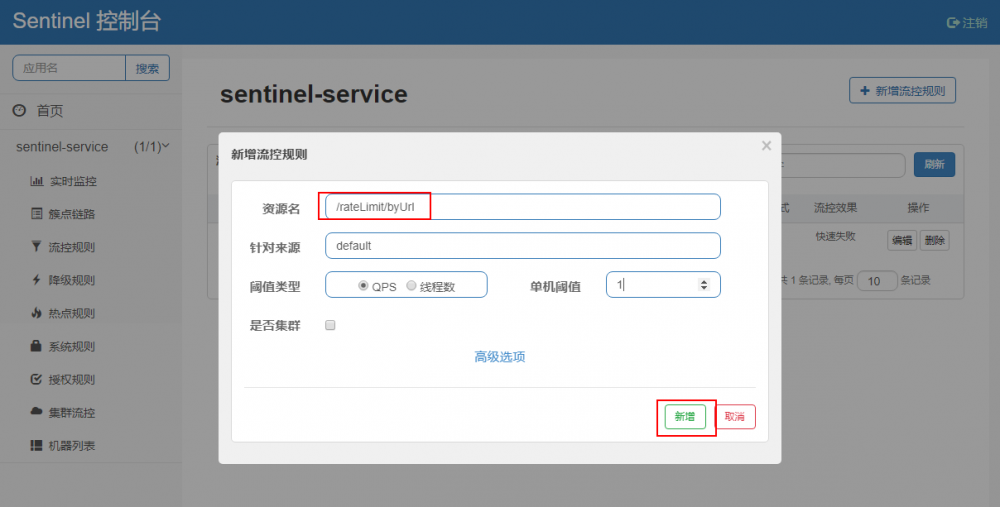
- 多次访问该接口,会返回默认的限流处理结果: http://localhost:8401/rateLimit/byUrl

自定义限流处理逻辑
我们可以自定义通用的限流处理逻辑,然后在@SentinelResource中指定。
- 创建CustomBlockHandler类用于自定义限流处理逻辑:
/**
* Created by macro on 2019/11/7.
*/
public class CustomBlockHandler {
public CommonResult handleException(BlockException exception){
return new CommonResult("自定义限流信息",200);
}
}
复制代码
- 在RateLimitController中使用自定义限流处理逻辑:
/**
* 限流功能
* Created by macro on 2019/11/7.
*/
@RestController
@RequestMapping("/rateLimit")
public class RateLimitController {
/**
* 自定义通用的限流处理逻辑
*/
@GetMapping("/customBlockHandler")
@SentinelResource(value = "customBlockHandler", blockHandler = "handleException",blockHandlerClass = CustomBlockHandler.class)
public CommonResult blockHandler() {
return new CommonResult("限流成功", 200);
}
}
复制代码
熔断功能
Sentinel 支持对服务间调用进行保护,对故障应用进行熔断操作,这里我们使用RestTemplate来调用nacos-user-service服务所提供的接口来演示下该功能。
- 首先我们需要使用@SentinelRestTemplate来包装下RestTemplate实例:
/**
* Created by macro on 2019/8/29.
*/
@Configuration
public class RibbonConfig {
@Bean
@SentinelRestTemplate
public RestTemplate restTemplate(){
return new RestTemplate();
}
}
复制代码
- 添加CircleBreakerController类,定义对nacos-user-service提供接口的调用:
/**
* 熔断功能
* Created by macro on 2019/11/7.
*/
@RestController
@RequestMapping("/breaker")
public class CircleBreakerController {
private Logger LOGGER = LoggerFactory.getLogger(CircleBreakerController.class);
@Autowired
private RestTemplate restTemplate;
@Value("${service-url.user-service}")
private String userServiceUrl;
@RequestMapping("/fallback/{id}")
@SentinelResource(value = "fallback",fallback = "handleFallback")
public CommonResult fallback(@PathVariable Long id) {
return restTemplate.getForObject(userServiceUrl + "/user/{1}", CommonResult.class, id);
}
@RequestMapping("/fallbackException/{id}")
@SentinelResource(value = "fallbackException",fallback = "handleFallback2", exceptionsToIgnore = {NullPointerException.class})
public CommonResult fallbackException(@PathVariable Long id) {
if (id == 1) {
throw new IndexOutOfBoundsException();
} else if (id == 2) {
throw new NullPointerException();
}
return restTemplate.getForObject(userServiceUrl + "/user/{1}", CommonResult.class, id);
}
public CommonResult handleFallback(Long id) {
User defaultUser = new User(-1L, "defaultUser", "123456");
return new CommonResult<>(defaultUser,"服务降级返回",200);
}
public CommonResult handleFallback2(@PathVariable Long id, Throwable e) {
LOGGER.error("handleFallback2 id:{},throwable class:{}", id, e.getClass());
User defaultUser = new User(-2L, "defaultUser2", "123456");
return new CommonResult<>(defaultUser,"服务降级返回",200);
}
}
复制代码
-
启动nacos-user-service和sentinel-service服务:
-
由于我们并没有在nacos-user-service中定义id为4的用户,所有访问如下接口会返回服务降级结果: http://localhost:8401/breaker/fallback/4
{
"data": {
"id": -1,
"username": "defaultUser",
"password": "123456"
},
"message": "服务降级返回",
"code": 200
}
复制代码
- 由于我们使用了exceptionsToIgnore参数忽略了NullPointerException,所以我们访问接口报空指针时不会发生服务降级: http://localhost:8401/breaker/fallbackException/2
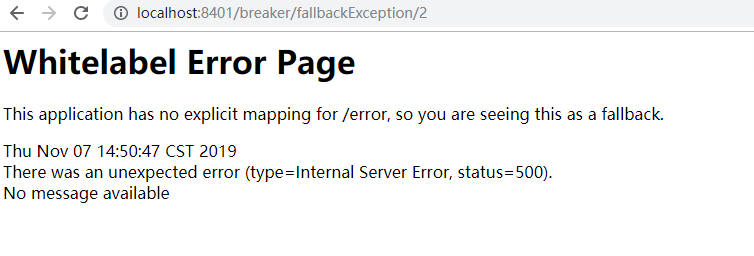
与Feign结合使用
Sentinel也适配了Feign组件,我们使用Feign来进行服务间调用时,也可以使用它来进行熔断。
- 首先我们需要在pom.xml中添加Feign相关依赖:
<dependency>
<groupId>org.springframework.cloud</groupId>
<artifactId>spring-cloud-starter-openfeign</artifactId>
</dependency>
复制代码
- 在application.yml中打开Sentinel对Feign的支持:
feign:
sentinel:
enabled: true #打开sentinel对feign的支持
复制代码
-
在应用启动类上添加@EnableFeignClients启动Feign的功能;
-
创建一个UserService接口,用于定义对nacos-user-service服务的调用:
/**
* Created by macro on 2019/9/5.
*/
@FeignClient(value = "nacos-user-service",fallback = UserFallbackService.class)
public interface UserService {
@PostMapping("/user/create")
CommonResult create(@RequestBody User user);
@GetMapping("/user/{id}")
CommonResult<User> getUser(@PathVariable Long id);
@GetMapping("/user/getByUsername")
CommonResult<User> getByUsername(@RequestParam String username);
@PostMapping("/user/update")
CommonResult update(@RequestBody User user);
@PostMapping("/user/delete/{id}")
CommonResult delete(@PathVariable Long id);
}
复制代码
- 创建UserFallbackService类实现UserService接口,用于处理服务降级逻辑:
/**
* Created by macro on 2019/9/5.
*/
@Component
public class UserFallbackService implements UserService {
@Override
public CommonResult create(User user) {
User defaultUser = new User(-1L, "defaultUser", "123456");
return new CommonResult<>(defaultUser,"服务降级返回",200);
}
@Override
public CommonResult<User> getUser(Long id) {
User defaultUser = new User(-1L, "defaultUser", "123456");
return new CommonResult<>(defaultUser,"服务降级返回",200);
}
@Override
public CommonResult<User> getByUsername(String username) {
User defaultUser = new User(-1L, "defaultUser", "123456");
return new CommonResult<>(defaultUser,"服务降级返回",200);
}
@Override
public CommonResult update(User user) {
return new CommonResult("调用失败,服务被降级",500);
}
@Override
public CommonResult delete(Long id) {
return new CommonResult("调用失败,服务被降级",500);
}
}
复制代码
- 在UserFeignController中使用UserService通过Feign调用nacos-user-service服务中的接口:
/**
* Created by macro on 2019/8/29.
*/
@RestController
@RequestMapping("/user")
public class UserFeignController {
@Autowired
private UserService userService;
@GetMapping("/{id}")
public CommonResult getUser(@PathVariable Long id) {
return userService.getUser(id);
}
@GetMapping("/getByUsername")
public CommonResult getByUsername(@RequestParam String username) {
return userService.getByUsername(username);
}
@PostMapping("/create")
public CommonResult create(@RequestBody User user) {
return userService.create(user);
}
@PostMapping("/update")
public CommonResult update(@RequestBody User user) {
return userService.update(user);
}
@PostMapping("/delete/{id}")
public CommonResult delete(@PathVariable Long id) {
return userService.delete(id);
}
}
复制代码
- 调用如下接口会发生服务降级,返回服务降级处理信息: http://localhost:8401/user/4
{
"data": {
"id": -1,
"username": "defaultUser",
"password": "123456"
},
"message": "服务降级返回",
"code": 200
}
复制代码
使用Nacos存储规则
默认情况下,当我们在Sentinel控制台中配置规则时,控制台推送规则方式是通过API将规则推送至客户端并直接更新到内存中。一旦我们重启应用,规则将消失。下面我们介绍下如何将配置规则进行持久化,以存储到Nacos为例。
原理示意图
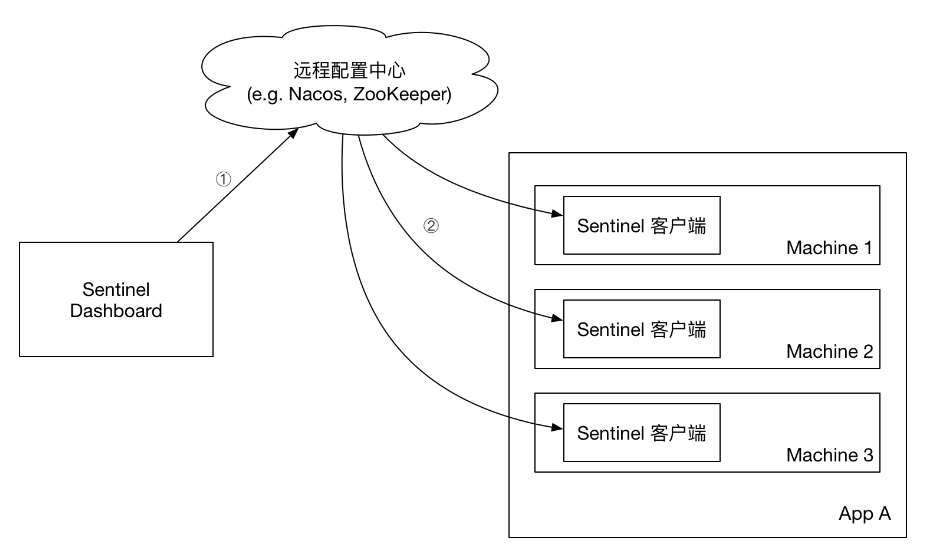
-
首先我们直接在配置中心创建规则,配置中心将规则推送到客户端;
-
Sentinel控制台也从配置中心去获取配置信息。
功能演示
- 先在pom.xml中添加相关依赖:
<dependency>
<groupId>com.alibaba.csp</groupId>
<artifactId>sentinel-datasource-nacos</artifactId>
</dependency>
复制代码
- 修改application.yml配置文件,添加Nacos数据源配置:
spring:
cloud:
sentinel:
datasource:
ds1:
nacos:
server-addr: localhost:8848
dataId: ${spring.application.name}-sentinel
groupId: DEFAULT_GROUP
data-type: json
rule-type: flow
复制代码
- 在Nacos中添加配置:
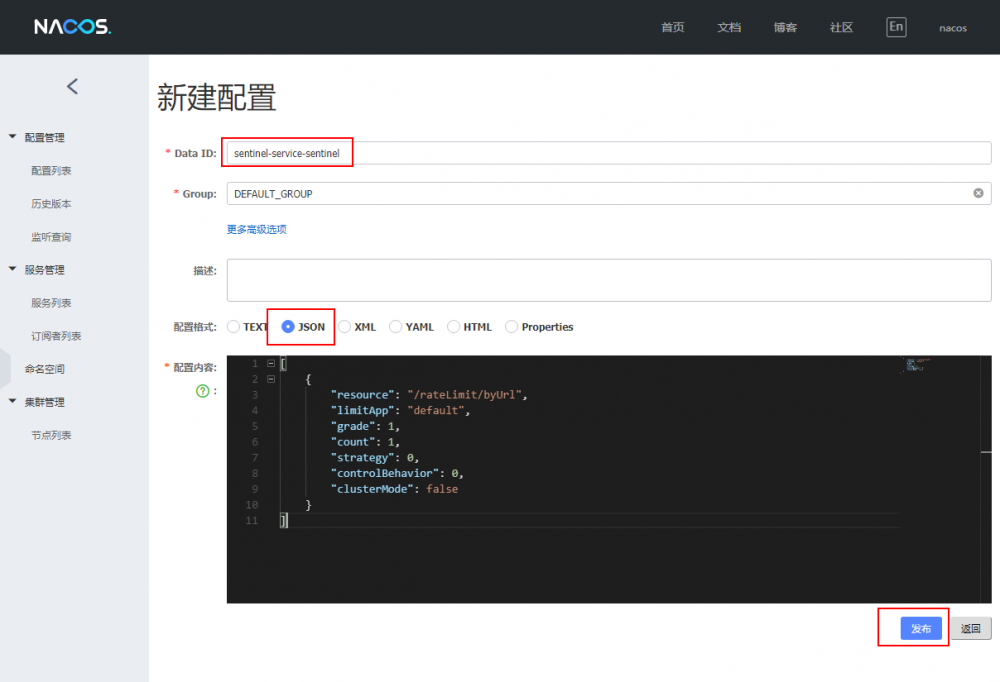
- 添加配置信息如下:
[
{
"resource": "/rateLimit/byUrl",
"limitApp": "default",
"grade": 1,
"count": 1,
"strategy": 0,
"controlBehavior": 0,
"clusterMode": false
}
]
复制代码
-
相关参数解释:
- resource:资源名称;
- limitApp:来源应用;
- grade:阈值类型,0表示线程数,1表示QPS;
- count:单机阈值;
- strategy:流控模式,0表示直接,1表示关联,2表示链路;
- controlBehavior:流控效果,0表示快速失败,1表示Warm Up,2表示排队等待;
- clusterMode:是否集群。
-
发现Sentinel控制台已经有了如下限流规则:
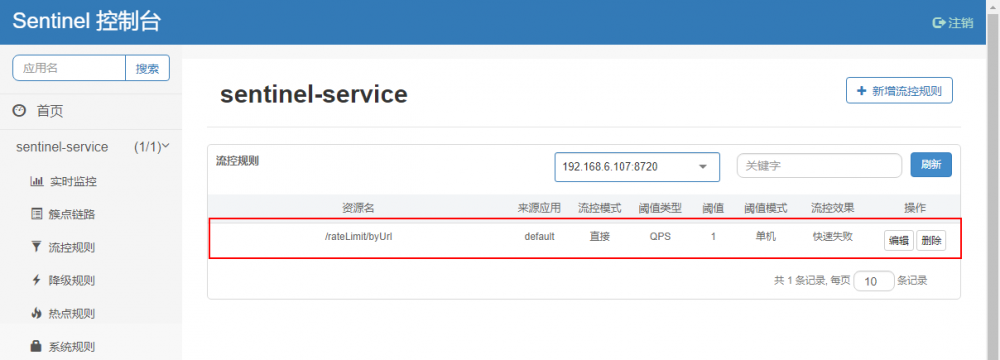
- 快速访问测试接口,可以发现返回了限流处理信息:

参考资料
Spring Cloud Alibaba 官方文档: github.com/alibaba/spr…
使用到的模块
springcloud-learning ├── nacos-user-service -- 注册到nacos的提供User对象CRUD接口的服务 └── sentinel-service -- sentinel功能测试服务 复制代码
- 本文标签: id Dashboard web 配置 CTO 开发 Word IO 注册中心 update js 安装 代码 参数 http 配置中心 java https map GitHub REST src bean Feign spring git 阿里巴巴 API value lib Service ribbon 2019 pom 集群 管理 XML client Transport Spring cloud 微服务 端口 cat IDE json dataSource message springcloud 限流 测试 线程 数据 实例 dubbo 下载 Sentinel QPS 定制 tar UI App 开源 ACE
- 版权声明: 本文为互联网转载文章,出处已在文章中说明(部分除外)。如果侵权,请联系本站长删除,谢谢。
- 本文海报: 生成海报一 生成海报二











![[HBLOG]公众号](https://www.liuhaihua.cn/img/qrcode_gzh.jpg)

